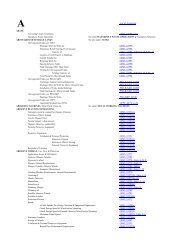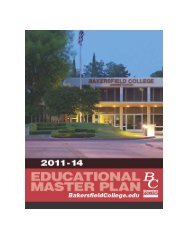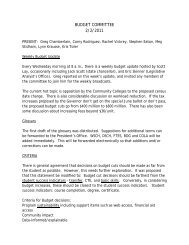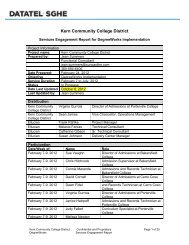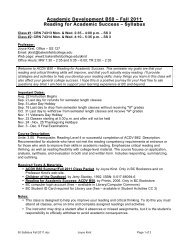Addendum with evidence (8.2 MB) - Accreditation - Bakersfield ...
Addendum with evidence (8.2 MB) - Accreditation - Bakersfield ...
Addendum with evidence (8.2 MB) - Accreditation - Bakersfield ...
You also want an ePaper? Increase the reach of your titles
YUMPU automatically turns print PDFs into web optimized ePapers that Google loves.
certificate standards. Wind industry employers present limited instructional program opportunities<br />
for the colleges. The College could consider forming partnerships <strong>with</strong> employers near college<br />
facilities, or developing strategies to incorporate wind turbine technician training into existing<br />
programs. Two-thirds of the jobs in the energy efficiency industry are traditional occupations, not<br />
new occupations. Colleges are advised to invest in new content for existing courses, build<br />
relationships <strong>with</strong> employers to create apprenticeships, and “pipeline” training programs, and direct<br />
the instruction to industry certification standards. The bio-energy industry, which is strongly tied to<br />
the agriculture industry, is projected to have slow growth, and therefore, few new employment<br />
opportunities. For the present, the colleges are advised to monitor state and federal policy or<br />
legislation that may support the industry in California. Alternative transportation as an industry is<br />
located <strong>with</strong>in large vehicle fleet operations. Where these are near a college, the recommended<br />
strategy is to embed alternative fuels education into existing electrical and automotive instructional<br />
programs. The compliance and sustainability employment opportunities span across several<br />
industries and affect both public and private employers. The greatest need in compliance and<br />
sustainability is knowledge of regulations and policy.<br />
These state and regional highlights of occupations for the future provide opportunities for<br />
those students willing and able to relocate. There are opportunities for students <strong>with</strong> different levels<br />
of education from industry certification to an associate degree or a bachelor’s degree. As noted<br />
below, there are some future employment opportunities in the local county economy as well. The<br />
labor market information below was developed by the California Employment Development<br />
Department (EDD) through surveys they conducted <strong>with</strong> business and industry. That work was<br />
completed in 2007 for the ten-year projection 2008-2018. At the time neither the survey respondents<br />
nor the officials at EDD could have anticipated the depth of the recession that started in 2008 or the<br />
protracted nature of the recovery <strong>with</strong> particularly severe consequences to state and local<br />
government employment. While the economy is recovering, it has been a relative “job-less” recovery<br />
<strong>with</strong> more employment growth in the private sector than in public sector jobs. The projections that<br />
follow will be interpreted <strong>with</strong> this caveat in mind.<br />
Through the year 2018, the EDD expects the fastest growing industry sectors in Kern<br />
County to be Education Services, Health Care and Social Assistance, each <strong>with</strong> an annual growth<br />
rate of about 4%. Several other sectors will exceed the average annual growth rate of 1.4%. These<br />
include Wholesale Trade (3.3% annual growth), Professional and Business Services (2.5% annual<br />
growth), and Leisure and Hospitality (2.1% annual growth). Between 2008 and 2018, approximately<br />
43,100 new jobs are expected from industry growth while 71,200 job openings are anticipated from<br />
net replacements. That is a combined total of more than 114,300 job openings. 13<br />
In Kern County, 50 occupations <strong>with</strong> the most job openings are expected to make up 57% of all<br />
job openings. The occupations <strong>with</strong> the highest growth numbers are predicted to be farm workers<br />
and laborers (crop, nursery, and greenhouse), cashiers, and retail salespersons. None of these are<br />
particularly high paying occupations and all usually require only short-term on-the-job training.<br />
Occupations requiring little to moderate amounts of on-the-job training (up to 12 months) make up<br />
35 of the 50 occupations <strong>with</strong> the most openings. Therefore, there are opportunities for the College<br />
to contribute to the economic development of the County by providing education and skill<br />
development experiences that will lead to higher-wage jobs. Occupations <strong>with</strong> growth expectations,<br />
and which require an Associate Degree or higher include management analysts, registered nurses,<br />
general and operations managers, elementary and secondary school teachers, farm, ranch and other<br />
13 State of California, Employment Development Department “2008-2018 Kern County Projection Highlights,” Labor<br />
Market Information Retrieved November 2, 2011 from http://www.labormarketinfo.edu.ca.gov<br />
81



